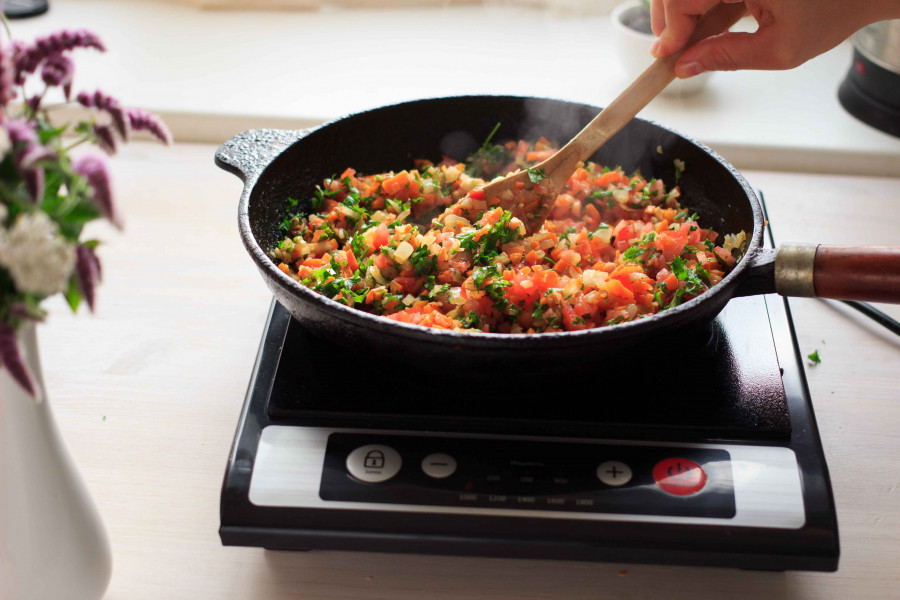
Observers say reducing tariffs will not be enough to promote electric cooking. SHUTTERSTOCK
Gagan Shrestha was cooking lentils one fine evening last week when the cooking gas ran out. Luckily for him, he had an alternative at hand.
“I had recently bought an induction stove for Rs4,500, so I didn’t have to worry,” Shrestha told the Post. He transferred the pot to the induction heater and went on with his cooking.
But then another thought struck his mind. What if the power goes out? But that did not happen, and the 34-year-old automobile mechanic from Balaju was able to enjoy a hearty dinner that evening.
Shrestha said he would keep an extra cylinder of cooking gas from now on, just in case.
Homemaker Shree Thapa has a similar story.
“I tried cooking rice a few times using electricity, but there are frequent power cuts. I have no plans to buy an induction stove,” said Thapa, 49. “During the office rush hour, I can’t risk power cuts. Cooking gas is reliable for me.”
Thapa has to prepare the meals on time because her husband needs to get to work and the children have to be at school on time.
Last July, the 456-megawatt Upper Tamakoshi Hydropower Project started generating electricity, transforming power-starved Nepal into an energy surplus country during the summer season.
The plant is the largest in the country, but due to the poor distribution network and old infrastructure, electricity supply is not regular.
“The electricity is not reliable,” said Thapa, a resident of Chalnakhel.
Irregular supply has prevented Nepalis from switching to electricity from liquefied petroleum gas (LPG) to do their cooking, leaving the country completely dependent on the imported fuel.
For state-owned monopoly Nepal Oil Corporation, the cooking gas business is a big money maker. But for the country, it’s a loss.
Decades ago, when Nepal was power-strapped, government policy was focused on promoting clean energy; and LPG was the top choice to prevent people from burning firewood and causing environmental degradation.
In 1995-96, Nepal used to import 18,600 tonnes of LPG annually. In 2000-01, according to reports, only 7.7 percent of Nepali households were found to be using LPG as the primary fuel for cooking.
Nepalis started using LPG in a big way from 1995-96 when it was formally introduced as an alternative to kerosene in urban and semi-urban areas.
Then load-shedding began, and at the same time, the government started imposing restrictions on collecting firewood. LPG demand then took off, reaching 115,813 tonnes in 2008-09, and kept climbing.
In the last two and a half decades, LPG imports jumped by 2,466 percent, according to Nepal Oil Corporation.
In 2020-21, Nepal spent Rs36 billion to import 477,422 tonnes of LPG. The LPG import bill is expected to double by the end of this fiscal year.
According to the Department of Customs, Nepal imported 441,363 tonnes of LPG worth Rs52 billion in the first 10 months of the current fiscal year ended mid-May.
LPG is becoming costlier. Sometimes it is not available easily, and consumers have to wait for weeks. Despite the hassles, Nepali consumers are still reluctant to cook food using electricity.
According to the Alternative Energy Promotion Centre, a cylinder of LPG cost Rs1,375 as of mid-2020, and considering that this quantity is sufficient for 30-60 days for a family of four, such a household would spend Rs8,250 per year on the fuel.
Regarding electricity, per-unit costs in Nepal are higher than in many South Asian countries, which discourages households from adopting it for cooking uses, the centre said.
But that is not all. Some consumers have noted that electricity is actually cheaper than LPG but its supply is unreliable, and households perceive it to be higher in cost, according to the centre’s report.
On May 22, the price of LPG increased by Rs200 to a record Rs1,800 per cylinder. Despite the hike, the fuel monopoly says it still incurs a loss of Rs879.75 on every cylinder of LPG sold.
Nepal’s imports of petroleum products—cooking gas, petrol, diesel, kerosene and aviation fuel—jumped to a staggering Rs243 billion in the first 10 months of the current fiscal year, according to the Department of Customs.
The country imports petroleum products in massive amounts, and calls are growing to replace LPG with electricity, particularly in the kitchen.
Sushil Bhattarai, deputy director general of Nepal Oil Corporation, said that the time had come to shift to electric cooking from LPG. “Prices are rising. We don’t know when this streak will end,” he said.
“We cannot afford to give subsidies on LPG. The price of LPG should be hiked as per the cost price. The government, however, can give subsidies to households to encourage people to shift to electric cooking,” said Bhattarai.
The government has also talked about promoting electric cooking in its Policies and Programmes for the fiscal year 2022-23 unveiled on Tuesday.
“The electricity tariff will be reviewed in order to increase consumption of electricity and gradually displace LPG use,” the policies and programmes state.
In order to encourage the use of electric ovens and other electrical goods in the kitchen, the Electricity Regulatory Commission had reduced the electricity tariff for households that use 150 units to 250 units per month by 50 paisa per unit to Rs9.50, starting from November 17.
But consumers say that is peanuts.
Stakeholders have stated that reducing tariffs alone will not be enough to promote electric cooking.
“As people’s primary concern is cost, a reduction in the electricity tariff is an important step to encouraging electric cooking,” said Subarna Prasad Kapali, managing director of Ajummery Bikas Foundation, a social enterprise providing expert advisory on energy to be used in households and communities.
State-owned power utility Nepal Electricity Authority knows that electricity can be cheaper, and it also knows that people are suffering from irregular power supply. But so far, the grievances of consumers have never been addressed.
Kul Man Ghising, managing director of the Nepal Electricity Authority, said it was vital to ensure uninterrupted supply of electricity to encourage people to switch to electric cooking.
“LPG cannot be replaced overnight. If people shift to electric cooking from LPG, it will increase load demand,” he said. “But since we don’t have proper infrastructure, it is immediately not possible to supply uninterrupted electricity supply as per demand.”
Ghising said they would require an additional 500-600 megawatts if all LPG cylinders in Kathmandu Valley were to be replaced.
“So, we have to develop more infrastructure—that is transmission lines, distribution systems and substations—to ensure there will be no power cuts,” he said. “For this, our current resources are not enough.”
According to experts, rising prices of cooking gas should be considered an opportunity to switch to electric cooking.
They say that during a crisis or when prices become unaffordable, it will be easier to change the mentality of people to shift to electric.
A large number of people had purchased electric stoves when there was a shortage of fuel including cooking gas after India imposed an embargo on Nepal in 2015 to express its displeasure against the adoption of a new constitution.
“People are exploring alternatives because of surging prices of cooking gas which is creating holes in people's pockets,” said Kapali. “People are also willing to adopt electric cooking as part of a modern lifestyle too.”
He says reliable electricity supply is the key.
According to a report—Assessment of Electric Cooking Targets for Nepal’s 2020 Nationally Determined Contributions—prepared by the Ministry of Forest and Environment, cutting down on LPG, which Nepal imports from India, would significantly reduce the trade deficit.
According to the report, a five-member middle-class family uses on average seven LPG cylinders in a year. After adopting e-cooking, the figure drops to three LPG cylinders a year, using both electricity and LPG for cooking.
With a saving of four cylinders per year per household, the existing 515,000 electric stove users would have avoided an import of 29,252 tonnes of LPG in 2018-19, which is 6.8 percent less than the actual LPG import of 429,609 tonnes that year.
Assuming an additional 1 million households will adopt electric cooking by 2025, the country will avoid an import of 86,052 tonnes of LPG in that year, the report said.
There has been growing use of electric appliances in kitchens, but no significant jump in their use.
The households use a combination of electric cooking appliances including electric rice cookers, microwave ovens, electric pressure cookers, roti makers, electric kettles and electric cook stoves.
The private sector sold about 50,000 induction stoves in the last three years till 2020, the report said.
According to a study conducted among selected households in Panchkhal Municipality, cooking on induction cook stoves was found to be almost 40 percent cheaper than using LPG cooktops.
Another lab-based study conducted by the Centre for Energy Studies showed a 42 percent saving when cooking on an induction device compared to cooking using LPG.
Besides being a cheaper option, the government has started to prioritise electric cooking in its policies.
The Energy White Paper issued by the Energy Ministry talks about promoting electric cooking in 100,000 households every year, and the scheme has been included in the 15th Five-Year Plan and the programmes of the Alternative Energy Promotion Centre.
However, the report of the Ministry of Forest and Environment pointed out a number of challenges in promoting the use of electric cooking.
“Peak load management is still challenging because of which people are not confident about the reliability of electricity supply during cooking hours,'' the report says.
Ghising said improving the reliability of electricity by improving infrastructure has been a major priority of the state-owned enterprise.
“If all kitchens switch to electric cooking, the nationwide power demand will grow by about 1,000 megawatts. We have to prepare the infrastructure to address this demand.”













